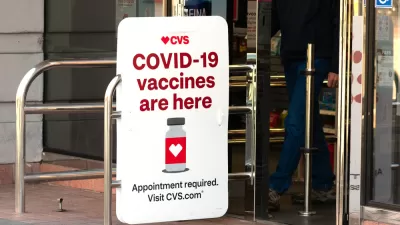The Centers for Disease Control and Prevention, acting on new data that it had yet to publish, changed its masking guidance on July 27 to reflect the prevalence of the virus in specific counties rather than basing it on a person's vaccination status.

With the U.S. seeing exponential growth of COVID-19 infections similar to the fall 2020 surge, the Centers for Disease Control and Prevention (CDC) took the bold step of revising its masking guidance previously issued on May 13, when daily new cases averaged just over 35,000 and had been plummeting since Jan. 10, when they averaged over 254,000.
"CDC scientists were so alarmed by the new research that the agency earlier this week significantly changed guidance for vaccinated people even before making new data public," reported Yasmeen Abutaleb, Carolyn Y. Johnson and Joel Achenbach for The Washington Post. The reversal on guidance for the fully vaccinated prompted public health experts to ask, "Wwhere's the data?"
To comprehend how much the Delta variant is a game-changer in the pandemic, consider the titles of the source article on July 29 and the Post's report on the first vaccination in the U.S. on Dec. 14, 2020.
Cases skyrocketing
On July 27, the 7-day average of new cases was just over 63,000. On July 29, the average was almost 72,000, an increase of 13% in two days–and over 150% from two weeks ago, according to The New York Times coronavirus tracker. Every state and territory, save Guam, saw at least double-digit growth in new cases for the past two weeks, with Utah on the low end at 32%, and 13 states showing a more than 200% increase.
New infections reached a nadir on July 5 when daily new cases averaged 10,600, but there were ominous signs from southwestern Missouri in June that the Delta variant threatened to upend progress against the coronavirus nationwide. The variant, first detected in India and barely registering in May, now accounts for 83% of infections nationwide.
America first
Once again, America is the global hot spot, leading the world in the 7-day average of daily new cases of COVID-19, according to The New York Times global coronavirus tracker on August 1:
- U.S: 78,433 (7-day average of daily new cases); 24 cases per 100,000 people; +148% from 2 weeks ago
- India: 40,560 (7-day average of daily new cases); 3 cases per 100k; +6% from 2 weeks ago
- Indonesia: 40,262 (7-day average of daily new cases); 15 cases per 100k; (-18%) from 2 weeks ago
Hospitalizations and deaths on the rise
According to the Times tracker, the 7-day average of hospitalized COVID patients in the U.S. was almost 38,000 on July 28, an increase of about 74% over the last two weeks and the highest since May 9. The 7-day average of daily new deaths on July 29 exceeded 300 on July 29 for the first time in over a month, an increase of about 10% over the last two weeks.
Compelling data moved CDC to release revised masking guidance without posting the data
"In recent days, I have seen new scientific data from recent outbreak investigations showing that the Delta variant behaves differently from past strains of the virus that cause Covid-19," stated CDC Director Rochelle Walensky in a media briefing on Tuesday, as reported by CNN.
"Information on the Delta variant from several states and other countries indicates that in rare occasions, some vaccinated people infected with the Delta variant after vaccinations may be contagious and spread the virus to others. This new science is worrisome and, unfortunately, warrants an update to our recommendations."
Internal document leaked to the Post
"The data and studies cited in the document played a key role in revamped recommendations that call for everyone — vaccinated or not — to wear masks indoors in public settings in certain circumstances, a federal health official said," add Abutaleb, Achenbach and Johnson.
"Although it’s rare, we believe that at an individual level, vaccinated people may spread the virus, which is why we updated our recommendation,” according to the federal health official, who spoke on the condition of anonymity because they were not authorized to speak publicly. “Waiting even days to publish the data could result in needless suffering and as public health professionals we cannot accept that.”
In other words, CDC felt it urgent to let vaccinated people know they should mask indoors in public places "if you are in an area of substantial or high transmission," states their revised webpage, "When You’ve Been Fully Vaccinated."
Do you live in an "area of substantial or high transmission?"
To find your county's transmission level, you can input the county name and state on CDC's COVID data tracker "integrated county view" webpage or hover over the U.S. map and click. Two metrics are used to determine the level of transmission:
- Weekly new cases per 100,000 people, aka case incidence
- COVID-19 test positivity rate (TPR)
The indicator with the higher level is used to determine the transmission level.
For the 7-day period from "Sat Jul 24 2021 - Fri Jul 30 2021," 74% of all counties are in the substantial and high transmission categories. Note the percentage change in counties in each category – red is growing while others decrease.
- 58% of U.S. counties are in the high transmission or red category, an increase of 17% since prior week: at least 100 weekly cases per 100,000 residents [~14 cases per 100k daily]; TPR: ≥10.0%
- 18% of counties are in substantial transmission or orange category, a decrease of half a percent since prior week: 50-99.99 cases per 100k residents [~7-13.9 cases per 100k daily]; TPR: 8-9.99%
- 18% of counties are in the moderate transmission or yellow category, a decrease of 12%: 10-49.99 cases per 100k people [~1.4- 6.9 per 100k daily]; TPR: 5-7.99%
- 6% of counties are in the low transmission or blue category, a decrease of almost 5%: 0-9.99 cases per 100k [up to 1.39 per 100k daily]; TPR: 0-4.99%
Most of the popular coronavirus trackers use daily, not weekly case incidence rates. The New York Times tracker shows the U.S. averaging 24 daily new cases per 100k residents on July 31, about 70% greater than the high (red) transmission threshold of 100 weekly cases per 100,000 residents (~14 daily new cases per 100k daily).
See two related posts on using coronavirus trackers:
- How Widespread Is the Coronavirus in Your Metro Area? [Covid Act Now database], January 19, 2021
- Do You Know Your COVID-19 Colors? [Brown School of Public Health's Risk Levels dashboard], July 29, 2020
What's in the leaked CDC document?
All 25 slides describing the new data were posted on the Post's website on Friday morning.
Slide 4 shows disease (infection), hospitalization and death incidence rates for the vaccinated and unvaccinated. Unvaccinated people are seeing an 8-fold higher rate of weekly new cases and a 25 times higher rate of hospitalizations and death. But the infection risk to the vaccinated has increased greatly with the Delta variant. The slide states:
- At current incidence, 35,000 symptomatic infections per week among 162 million vaccinated Americans
That's a weekly incidence rate of 21.4 "breakthrough cases" per 100,000 vaccinated people or 3 per 100k daily. Applying CDC's own metrics on risk assessment, that incidence rate falls in the moderate transmission or yellow category,
The U.S. is averaging eight times that rate among the total population as noted in the above section.
Breakthrough infections
These symptomatic breakthrough cases may not be recorded by the CDC as they transitioned on May 1, 2021 "from monitoring all reported vaccine breakthrough cases to focus on identifying and investigating only hospitalized or fatal cases due to any cause," according to their breakthrough webpage which lists current data.
As of July 26, 2021, more than 163 million people in the United States had been fully vaccinated against COVID-19.
During the same time, CDC received reports from 49 U.S. states and territories of 6,587 patients with COVID-19 vaccine breakthrough infection who were hospitalized or died.
That's 0.004%, but it's not a rate – it's a percentage of cumulative, potentially life-threatening vaccine breakthrough infections among all fully vaccinated Americans since December 14, 2020. As many experts have said, Delta is a game-changer, particularly in terms of breakthrough infections.
"Now some public health experts and lawmakers are pressuring the CDC to reverse its decision and collect comprehensive data on infections in vaccinated people — from mild to severe," reports Politico on July 30.
CDC publishes the data
On Friday afternoon, CDC posted the compelling data as one of two new COVID-19 reports on their Morbidity and Mortality Weekly Report (MMWR) webpage as early releases:
Here's how The Boston Globe, which has been covering the coronavirus cluster that originated on Cape Cod (Barnstable County) since it was detected and is the basis of the CDC report, in their Fast Forward newsletter on Friday morning:
Well, this is scary: 74 percent of the COVID-19 cases from a massive outbreak on Cape Cod after the Fourth of July occurred in vaccinated people.
The outbreak started in Provincetown, which was packed with visitors over the holiday weekend and in the two weeks after. Here are the relevant numbers:
Cases linked to Provincetown outbreak so far: 882
Cases among Mass. residents who visited P'town: 469
Of those 469, number who were fully vaccinated: 346
Of those 346, number who had symptoms: 274
The most common symptoms were a cough, headache, sore throat, myalgia, and fever.
Also, officials tested specimens from 133 people and found the Delta variant in 90 percent of them.
Seven of the 882 cases resulted in hospitalizations but all patients survived. The Globe didn't indicate if breakthroughs were among them.
Physiology of breakthroughs
The final words go to Anthony Fauci, the nation's foremost infectious disease expert and chief medical advisor to President Biden, and MSNBC host Chris Hayes who asked him the right questions in a 6-minute interview (via YouTube) on his show on July 27. Hayes's lightbulb moment occurs after Fauci explains (at 3:20):
Now that we have a Delta variant, that has changed the entire landscape because when you look at the level of virus in the nasopharynx of a vaccinated peron who gets a breakthrough infection with Delta, it is exactly the same as the level of virus in a unvaccinated person who is infected. That's the problem. So those data are very compelling and that triggered the change in the CDC guidelines.
See Associated Press: Study: Vaccinated people can carry as much virus as others, July 30.
Related in Planetizen:
- Pandemic Geography: Missouri Outbreak Driven by Delta Variant, June 21, 2021
- Will CDC's Revised Guidance for Fully Vaccinated People Prolong the Pandemic? May 17, 2021
- Pandemic Endgame: Redefining the Herd Immunity Goal, May 4, 2021
- Fourth Surge May Be a Second Wave, April 12, 2021 [Dr. Michael Osterholm had it right, he was just three months early and had the wrong variant]
-
Awaiting the Mutant Storm(s), February 4, 2021
FULL STORY: ‘The war has changed’: Internal CDC document urges new messaging, warns delta infections likely more severe

Planetizen Federal Action Tracker
A weekly monitor of how Trump’s orders and actions are impacting planners and planning in America.

Maui's Vacation Rental Debate Turns Ugly
Verbal attacks, misinformation campaigns and fistfights plague a high-stakes debate to convert thousands of vacation rentals into long-term housing.

San Francisco Suspends Traffic Calming Amidst Record Deaths
Citing “a challenging fiscal landscape,” the city will cease the program on the heels of 42 traffic deaths, including 24 pedestrians.

Defunct Pittsburgh Power Plant to Become Residential Tower
A decommissioned steam heat plant will be redeveloped into almost 100 affordable housing units.

Trump Prompts Restructuring of Transportation Research Board in “Unprecedented Overreach”
The TRB has eliminated more than half of its committees including those focused on climate, equity, and cities.

Amtrak Rolls Out New Orleans to Alabama “Mardi Gras” Train
The new service will operate morning and evening departures between Mobile and New Orleans.
Urban Design for Planners 1: Software Tools
This six-course series explores essential urban design concepts using open source software and equips planners with the tools they need to participate fully in the urban design process.
Planning for Universal Design
Learn the tools for implementing Universal Design in planning regulations.
Heyer Gruel & Associates PA
JM Goldson LLC
Custer County Colorado
City of Camden Redevelopment Agency
City of Astoria
Transportation Research & Education Center (TREC) at Portland State University
Jefferson Parish Government
Camden Redevelopment Agency
City of Claremont





























